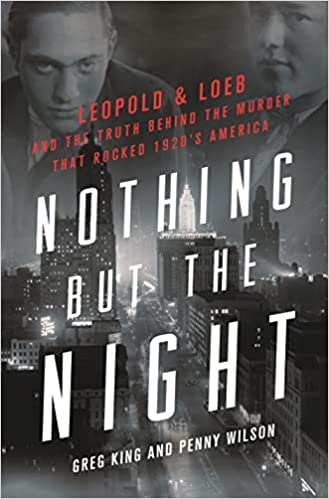Nothing But the Night: Leopold & Loeb and the Truth Behind the Murder That Rocked 1920’s America by Greg King, Penny Wilson
In May 1924, the headlines blared and the public became transfixed by a kidnapping that ended in a gory murder. Lured into a car a block from his home in the elegant south Chicago neighborhood of Kenwood, 14-year old Bobby Franks stopped breathing 20 miles away in a nature preserve. While the kidnapper-killers placed an ominous phone call and issued a ransom note, reporters and police quickly followed leads.
Within 24 hours, the boy’s half-naked body was found stuffed into a culvert. After a week of investigation and interrogation, including the discovery of a pair of eyeglasses dropped near the scene, 19-year old Nathan Leopold and 18-year old Richard Loeb were charged in the case.
In Nothing But the Night: Leopold & Loeb and the Truth Behind the Murder That Rocked 1920’s America (St. Martin’s Press), Greg King and Penny Wilson return us to “the crime of the century,” as the murder became known.
Leopold and Loeb — smart, wealthy and Jewish; recent college graduates, neighbors (as was the victim), devotees of true crime stories and Nietzsche — have been the subject of quite a few novels, histories, films and plays. King and Wilson, who have an affinity with tales of death and disaster, have a new take on the kidnapping and murder of Bobby Franks.
AN UNENDING INVESTIGATION
While Leopold and Loeb ate steak in the Cook County Jail, the prosecutors and defense lawyers worked around the clock, for the trial date had been set for July. They gathered evidence, consulted with experts, and sought character witnesses. They reconstructed the timeline of the crime; learned that the killers almost called it off for want of a suitable victim. But the investigators kept running up against the question of who masterminded it. Loeb and Leopold each pointed at the other.
Among the findings that became public was a sexual relationship between Loeb and Leopold. Between 1920 and 1924 they were occasional lovers, taking great pains to hide their attraction from friends and family. Notwithstanding the risqué culture of the Roaring Twenties, the word “perversion” stood in for “homosexuality.” There was some evidence that Bobby might have been sexually assaulted, and one of the very unfortunate outcomes of the trial would be the identification of homosexuality with predatory behavior.
It was the age of Freud, and psychiatrists were retained as expert witnesses for the defense and the prosecution. Each met with Leopold and Loeb, plumbing their psyches and fantasies, often getting played yet managing to reconstruct two childhoods that were characterized by benign neglect. Leopold’s stories of an overbearing governess who forced him and his brother to please her sexually were especially disturbing.
Psychiatrists also noted Leopold’s desire for control, pain, and humiliation and Loeb’s reckless, thrill-seeking nature. Well before they plotted kidnapping and murder, Leopold and Loeb had cheated at cards, set fires, burgled fraternity houses, and likely committed several other violent crimes in the neighborhood. Ultimately, the defense psychiatrists found “mental illness” but not insanity. The psychiatrists for the prosecution found nothing abnormal.
A TRIAL SHAPED BY AMERICAN VALUES
Inevitably, the case fueled antisemitism and accusations of lax morals. Observers criticized parents and society at large for allowing a permissive youth culture to flourish. 1920 had been the first census year when more Americans lived in cities than in the country, accentuating a socio-economic divide.
While radio reached a mass audience, its programs juxtaposed “old” and “new” American values. And in all kinds of communities, the advent of extracurricular activities and availability of cars concerned administrators, teachers, parents, and clergy who “were haunted by a specter of sub rosa youth life that was probably far worse than the reality,” wrote historian Paula Fass.
The authors plunge the reader into the whirlwind 32-day trial, through the high heat of summer in a sixth-floor courtroom. Wisely, Leopold and Loeb’s families stuck together and hired the eminent, impassioned lawyer Clarence Darrow to defend their sons. Darrow liked to argue unpopular cases and opposed the death penalty.
The State’s Attorney expected a plea of not guilty by reason of insanity but Darrow had the murderers plead guilty. This strategy eliminated the possibility of a jury trial; now it would be a sentencing by a judge.
Unquestionably, Richard Loeb and Nathan Leopold had murdered Bobby Franks. Their courtroom behavior was offensive: giggling, smirking, sneering, feigning boredom. Leopold in particular showed no remorse, insisting “My crime was getting caught.”
Nevertheless, Darrow effectively portrayed them as victims of mental illness, “alienated, scarred by past traumas,” the authors write. They were reduced to hapless boys who could not be held accountable for their own reprehensible behavior. The judge gave each life imprisonment plus 99 years — but they didn’t hang.
This is a story that never grows old. With new research and analysis, King and Wilson have given us valuable insight and a fine interpretive history in Nothing But the Night.
About Greg King:
Greg King is the author of many internationally published works of history, including The Last Voyage of the Andrea Doria. His work has appeared in the Washington Post, Majesty Magazine, Royalty Magazine and Royalty Digest. He lives in the Seattle area.
About Penny Wilson:
Penny Wilson is the author of Lusitania and The Last Voyage of the Andrea Doria with Greg King and several internationally published works of history on late Imperial Russia. Her historical work has appeared in Majesty Magazine, Atlantis Magazine and Royalty Digest. She lives in Southern California with her husband and three Huskies.





